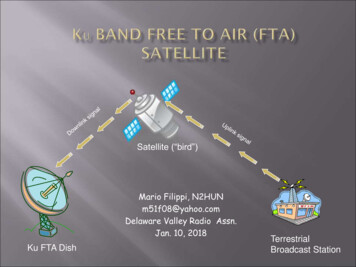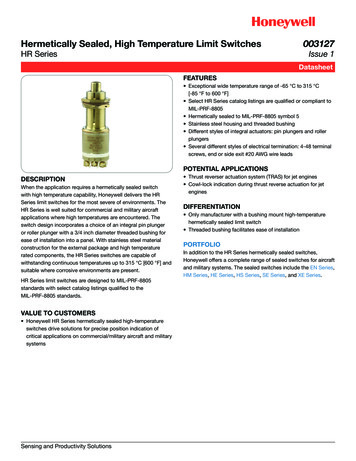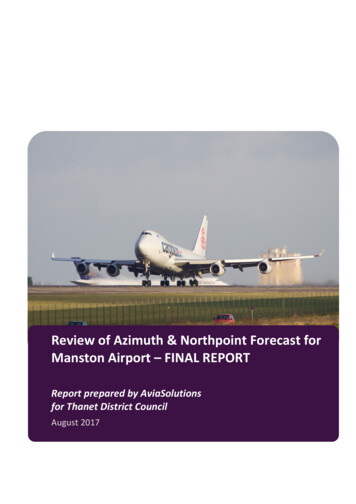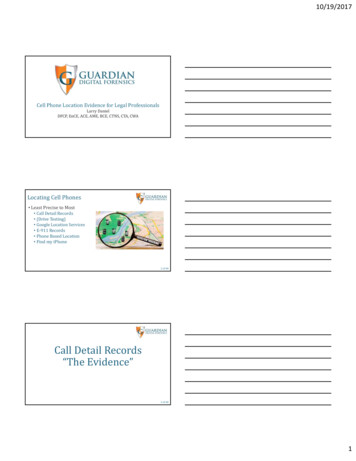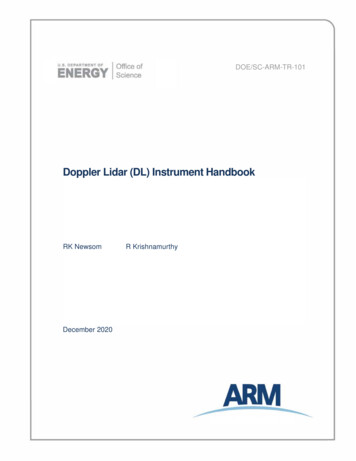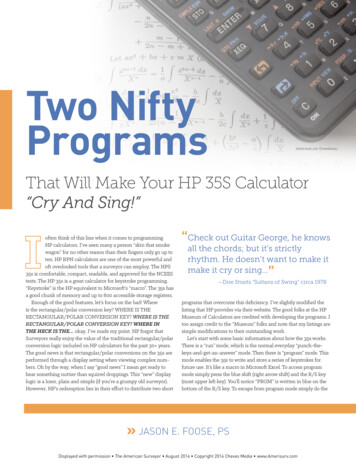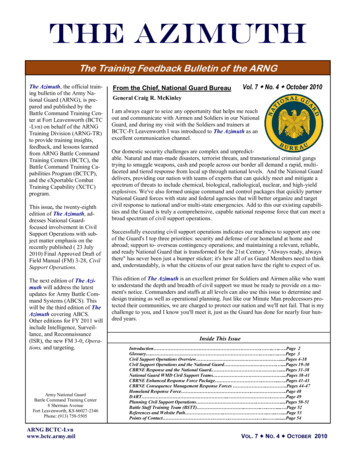
Transcription
The AzimuthTHE AZIMUTHTRAINING FEEDBACK AND LESSONS LEARNEDNEWSThe Training Feedback Bulletin of the ARNGThe Azimuth, the official training bulletin of the Army National Guard (ARNG), is prepared and published by theBattle Command Training Center at Fort Leavenworth (BCTC-Lvn) on behalf of the ARNGTraining Division (ARNG-TR)to provide training insights,feedback, and lessons learnedfrom ARNG Battle CommandTraining Centers (BCTC), theBattle Command Training Capabilities Program (BCTCP),and the eXportable CombatTraining Capability (XCTC)program.This issue, the twenty-eighthedition of The Azimuth, addresses National Guardfocused involvement in CivilSupport Operations with subject matter emphasis on therecently published ( 23 July2010) Final Approved Draft ofField Manual (FM) 3-28, CivilSupport Operations.The next edition of The Azimuth will address the latestupdates for Army Battle Command Systems (ABCS). Thiswill be the third edition of TheAzimuth covering ABCS.Other editions for FY 2011 willinclude Intelligence, Surveillance, and Reconnaissance(ISR), the new FM 3-0, Operations, and targeting.Army National GuardBattle Command Training Center8 Sherman AvenueFort Leavenworth, KS 66027-2346Phone: (913) 758-5505ARNG BCTC-Lvnwww.bctc.army.milFrom the Chief, National Guard BureauVol. 7 No. 4 October 2010General Craig R. McKinleyI am always eager to seize any opportunity that helps me reachout and communicate with Airmen and Soldiers in our NationalGuard, and during my visit with the Soldiers and trainers atBCTC-Ft Leavenworth I was introduced to The Azimuth as anexcellent communication channel.Our domestic security challenges are complex and unpredictable. Natural and man-made disasters, terrorist threats, and transnational criminal gangstrying to smuggle weapons, cash and people across our border all demand a rapid, multifaceted and tiered response from local up through national levels. And the National Guarddelivers, providing our nation with teams of experts that can quickly meet and mitigate aspectrum of threats to include chemical, biological, radiological, nuclear, and high-yieldexplosives. We've also formed unique command and control packages that quickly partnerNational Guard forces with state and federal agencies that will better organize and targetcivil response to national and/or multi-state emergencies. Add to this our existing capabilities and the Guard is truly a comprehensive, capable national response force that can meet abroad spectrum of civil support operations.Successfully executing civil support operations indicates our readiness to support any oneof the Guard's I top three priorities: security and defense of our homeland at home andabroad; support to- overseas contingency operations; and maintaining a relevant, reliable,and ready National Guard that is transformed for the 21st Century. "Always ready, alwaysthere" has never been just a bumper sticker; it's how all of us Guard Members need to thinkand, understandably, is what the citizens of our great nation have the right to expect of us.This edition of The Azimuth is an excellent primer for Soldiers and Airmen alike who wantto understand the depth and breadth of civil support we must be ready to provide on a moment's notice. Commanders and staffs at all levels can also use this issue to determine anddesign training as well as operational planning. Just like our Minute Man predecessors protected their communities, we are charged to protect our nation and we'll not fail. That is mychallenge to you, and I know you'll meet it, just as the Guard has done for nearly four hundred years.Inside This IssueIntroduction . . . .Page 2Glossary . . . . .Page 3Civil Support Operations Overview .Pages 4-18Civil Support Operations and the National Guard . . .Pages 19-30CBRNE Response and the National Guard. . .Pages 31-38National Guard WMD Civil Support Teams .Pages 38-41CBRNE Enhanced Response Force Package . . .Pages 41-43CBRNE Consequence Management Response Forces . .Pages 44-47Homeland Response Force . .Page 48DART . . Page 49Planning Civil Support Operations . .Pages 50-51Battle Staff Training Team (BSTT) . . . . Page 52References and Website Path . . . .Page 53Points of Contact . . . . .Page 54VOL. 7 NO. 4 OCTOBER 2010
NTHE AZIMUTHTRAINING FEEDBACK AND LESSONS LEARNEDEWSINTRODUCTIONThis edition of The Azimuth, CivilSupport Operations and The NationalGuard, has been prepared to enhanceSoldier, commander, and staff understanding of the recent updates to therecently published FM 3-28, CivilSupport Operations and provide abasic primer for the National Guard‘sbroad and complex support to civilsupport operations. The centergraphic on this page reflects the civilsupport slice of the broader spectrumof support requirements, all of whichinvolve the National Guard.The US military has provided supportto civil authorities in response to civilemergencies and natural disasters dating back to its codification in the Truman era. The terminology applied tothis function has varied over the years:military assistance, or military supportto civil authorities; military support ofcivil defense; and employment of military resources in natural disaster emergencies within the United States. Although the US military has been authorized to provide support to civil authorities in response to major disasters andelements, planning support, advisors,and technical experts to assist civilauthority. In some situations, civilauthority may have become so diminished that the company commanderhas the most effective command andcontrol (C2) system in the area. Insuch cases, commanders must determine where their objectives and planscomplement or conflict with those ofother key agencies.This edition of The Azimuth, whileserving as a general informationsource for civil support operations, also provides unitcommanders and staffs withinsight regarding the numerous complex tasks they mayhave to perform. Readers areencouraged to review the taskpossibilities highlighted bythe operational and tacticalconsiderations tools for domestic disaster response(pages 24-29) and CBRNEresponse (pages 32-35).The following quote from FM 3SPECTRUM OF SUPPORT-28 provides an excellent overall perspective: ―All civil support operations buttress the capabilities of civil authoritieswithin the United States. TheHomeland Securitymechanisms that regulate civilsupport come from law, policy,regulation, and directive. Civilsupport operations requireArmy leaders to understand anEmergencyPreparednessenvironment shaped primarilyby federal, state, local, andCivil SupportHomeland DefenseThis edition of The Azimuthtribal agencies, and circumwas reviewed by the Comscribed by law. Nowhere is thisbined Arms Center (CAC),more striking than in theCombined Arms Doctrineroles of the National Guard.Division (CADD).In sharp contrast to stabilityoperations, Army forces may conductemergencies since 1951, the events ofcivil support operations with NationalSeptember 11, 2001 significantlyGuard forces responding under thechanged its scope and importance.direction of a governor or alongsideactive duty forces as part of a coordiCivil support operations are typicallynated national response. The propojoint and interagency. The potential fornent has made every effort to keepduplication of effort and working atArmy civil support doctrine consistentcross-purposes is high, so unity of efwith appropriate laws, policies, regula- fort requires a common understandingtions, and directives of the federal andof the purposes and direction of all parThe information presented in this edition ofstate governments, the Department ofticipants.The Azimuth is provided as tips, techniques,Defense, the Department of the Army,and procedures (TTP), as well as lessonsand the National Guard. In any caseEnsuring unity of effort and efficientlearned. This information is tied to currentwhere Army doctrine differs, the laws, use of resources also requires constantdoctrine, where applicable.policies, regulations, and directivescoordination. National Guard forcestake precedence.‖enhance unity of effort by establishingeffective command and control procedures and by providing liaisonARNG BCTC-Lvnwww.bctc.army.mil2VOL. 7 NO. 4 OCTOBER 2010
NTHE AZIMUTHTRAINING FEEDBACK AND LESSONS LEARNEDEWSGLOSSARYAJADVON — advanced echelonALS — Analytical Laboratory SystemARNG-TR — Army National Guard Training DivisionASCC — Army Service Component Command(er)JET — Joint Enabling TeamJFHQ-State — Joint Force Headquarters-StateJFLCC — Joint Force Land Component Command(er)JFO — Joint Field OfficeJOA — joint operations areaJRSOI — joint reception, staging, onward movement, andintegrationJTF — joint task forceJTF-CS — Joint Task Force-Civil SupportJVB — Joint Visitors BureauBBCTC-Lvn — Battle Command Training CenterLeavenworthBCTCP — Battle Command Training CapabilitiesProgramBCTP — Battle Command Training ProgramBSI — base support installationNNGO — Non-governmental OrganizationNGRF — National Guard Reaction ForceNIMS — National Incident Management SystemNRF — National Response FrameworkCC2CRE — Consequence Management C2 ElementCBRNE — Chemical, Biological, Radiological, Nuclear,and High-Yield ExplosiveCCMRF — CBRNE Consequence Management ResponseForceCDC — Centers for Disease Control and PreventionCERFP — CBRNE Enhanced Response Force PackageCIP-MAA — Critical Infrastructure Program-MissionAssurance AssessmentCJCS — Chairman, Joint Chiefs of StaffCM — consequence managementCST — Civil Support TeamOOPCON — operational controlPPFO — Principal Federal OfficerPPE — personal protective equipmentQQDR — Quadrennial Defense ReviewRRDD — radiological dispersion deviceRFA — request for assistanceRMP — Response Management PlanROC — rehearsal of concept drillDDART — Domestic All-hazards Response TeamDCE — Defense Coordinating ElementDCO — Defense Coordinating OfficerDCRF — Defense CBRNE Response ForceDHS — Department of Homeland SecurityDSCA — Defense Support of Civil AuthoritiesSSCO — State Coordinating OfficerSECDEF — Secretary of DefenseTETACON — tactical controlTAG — The Adjutant General (National Guard)TIC — toxic industrial chemicalsTIM — toxic industrial materialsTPFDD — Time-phased Force and Deployment DataTSC — Theater Security CooperationEMAC — Emergency Management Assistance CompactFFEMA — Federal Emergency Management AgencyFOB — forward operating baseFSX — Full-Spectrum ExerciseGUGIS — Geographic Information SystemUCS — Unified Command SuiteUSARNORTH — United States Army NorthUSJFCOM — United States Joint Forces CommandUSNORTHCOM — United States Northern CommandUSPACOM — United States Pacific CommandHHAZMAT — hazardous material(s)HD — homeland defenseHRF — Homeland Response ForceHSPD — Homeland Security Presidential DirectiveWIWMD — weapons of mass destructionWMD-CST — Weapons of Mass Destruction Civil SupportTeamIAA — incident awareness and assessmentICS — Incident Command SystemINMARSAT — International Maritime SatelliteARNG BCTC-Lvnwww.bctc.army.mil3VOL. 7 NO. 4 OCTOBER 2010
NTHE AZIMUTHTRAINING FEEDBACK AND LESSONS LEARNEDEWSCIVIL SUPPORT OPERATIONS OVERVIEWGeneralThe principal reference for preparation of this edition of The Azimuth is the 23 July 2010 Final Approved Draft of FM 3-28,Civil Support Operations. While it is not final doctrine, it provides the most up-to-date information on civil support operations available. Civil support operations are the fourth element of full spectrum operations and are similar to stability operations in several ways. Both revolve around civilians on the ground within land areas of operation and both involve supporting tasks that require Army forces to provide essential services and work with civil authorities. However, they are quite different with regard to terms of law, military chain of command, the use of deadly force, and interagency processes. The principal difference is where the support operations occur . . . within or outside the United States and its territories. Note thefollowing graphic from FM 3-28.Operations conducted outside the United eOffenseDefenseCivilSupportOperations conductedwithin the United StatesThe mission determines the relative weight of effort between the elements.NOTEThis edition of The Azimuth employs numerous“smart cards” that are intended to highlight key information “takeaways” for commanders and staffs.Smart CardCivil support operations encompass supportprovided by the components of the Army to civilauthorities within the United States and its territories. This includes support provided by theregular Army, Army Reserve, and NationalGuard. FM 3-28 The Army National Guard has a dual role during civil support operations federal capacityunder command of the President and when integrated with Regular Army units as part of afederal military joint task force. The National Guard provides each state, territory, and the District of Columbia withmilitary capability to conduct civil support operations when directed by their respectiveGovernors, as part of a joint task force-state.ARNG BCTC-Lvnwww.bctc.army.mil4VOL. 7 NO. 4 OCTOBER 2010
NTHE AZIMUTHTRAINING FEEDBACK AND LESSONS LEARNEDEWSCIVIL SUPPORT OPERATIONS OVERVIEWWhat’s InvolvedPrimary Civil Support TasksThere are four primary civil support tasks: Provide support for domestic disasters Provide support for domestic chemical, biological, radiological, nuclear, or high-yield explosives (CBRNE) incidents Provide support for domestic civilian law enforcement agencies Provide other designated supportExamples of missions for each are included in the following smart card.Smart CardProvide Support for DomesticDisastersProvide Support for DomesticCBRNE Incidents Response to natural and manmadedisasters Response to all hazards exceptCBRNE Provide Other Designated SupportProvide Support for DomesticCivilian Law Enforcement Agencies Terrorist attacksIndustrial accidentsPandemic influenzaHuman, animal, or crop diseases Civil disturbancesSupport during disastersEquipment and trainingState and federal counterdrug effortsBorder securityNational special security eventsOther special eventsWildfire responseCritical infrastructure protectionAugmentation of federal agenciesCivil Support FundamentalsAlthough civil support missions are unique, certain fundamentals drive the actions of those who are designated to executethem. These fundamentals are included in the following smart card.Smart Card The primary purposes of civil support are to save lives, alleviate suffering, and protect property. The law defines every aspect of civil support operations: who has jurisdiction; who responds; andthe restraints and constraints imposed on Soldiers. Civilian officials direct civil support operations. They set the priorities. The Army supports them. All cost associated with civil support missions must be documented. The military end state is reached when civilian authorities can fulfill their responsibilities withoutmilitary assistance.ARNG BCTC-Lvnwww.bctc.army.mil5VOL. 7 NO. 4 OCTOBER 2010
NTHE AZIMUTHTRAINING FEEDBACK AND LESSONS LEARNEDEWSCIVIL SUPPORT OPERATIONS OVERVIEWWhat’s Involved (cont)NOTEKey Military Aspects of Civil Support Domestic EnvironmentsIn civil support operations, all levels of response (local, state, and Army forces conduct civil support operations only in the United States and its possessions and federal) may occur siterritories. Army forces do not conduct civil support operations overseas.multaneously. FM 3-28Smart Card Department of Defense is not in the lead in civil support operations; Department of Defensesupports a primary agency. The state National Guard is not the primary agency for civil support to its respective state. StateNational Guard forces support state agencies. In civil support operations, numerous relief efforts—local, state, and national—may occursimultaneously. Each has its own chain of command. A city mayor may control a local response. Atribal leader may control a tribal response. A governor may control a state response. The Presidentcontrols the national response and the federal military response. The Secretary of Defense andsupported combatant commander command and control federal military forces. Civil support is neither homeland defense nor homeland security. Federal military forces contributeto homeland security by conducting homeland defense and civil support operations. The same istrue for state National Guard forces. Department of Defense and State National Guard forces work with the Department of HomelandSecurity and other agencies to anticipate requirements. This includes planning, preparation, andtraining for contingencies involving state National Guard and federal military forces. In a civil support operation, a defense coordinating officer coordinates with a federal coordinatingofficer as the Secretary of Defense's primary agent. Federal military forces conduct civil support as part of a joint Service and interagency effort, underthe command and control of the supported combatant commander. Effective civil support operations depend on coordination with state and federal Interagencypartners. Military forces conduct civil support operations under state and federal laws. Many tactical civil support tasks are similar to tactical stability tasks, with some importantdifferences. Military forces receive reimbursement for the costs of civil support missions only ifthey maintain a detailed record of operations and associated costs.Key PlayersThe myriad organizations that comprise the National capabilities to execute civil support operations represent one ofthe most complex C2 situations imaginable. When considering command and support relationships, command post(CP) operations, communications, liaison, and control measures, the adjustments that must be made to adapt forces totheir supporting roles are challenging. It is not unusual during large-scale civil support operations for state NationalGuard and Department of Defense (DoD) military forces to operate in overlapping areas under separate chains of command. Success when dealing with a parallel command structure depends on close and continuous coordination. Making decisions regarding a particular operation often requires the collective effort of state and federal government andmilitary leaders .The key players in civil support operations are too numerous to address in any detail within the confines of this editionof The Azimuth, so only the State Joint Force Headquarters, Joint Task Force Headquarters-State (JFHQ-State), National Guard components, United States Northern Command (USNORTHCOM), as a combatant command, UnitedStates Army North (USARNORTH), as an Army component command, and Joint Task Force-Civil Support (JTF-CS),as a standing joint task force headquarters (HQ), are highlighted.ARNG BCTC-Lvnwww.bctc.army.mil6VOL. 7 NO. 4 OCTOBER 2010
NTHE AZIMUTHTRAINING FEEDBACK AND LESSONS LEARNEDEWSCIVIL SUPPORT OPERATIONS OVERVIEWKey Players (cont)PresidentStructureGovernorSecretary riesJoint ForceHeadquartersStateServiceComponentsArmy and AirNational GuardServiceComponentsJoint TaskForce-StateParallelTitle 10 JointForce rector of StateEmergencyManagementAgencyCommandSecretary ofDefenseTitle 10 JointTask ForceArmy NationalGuard UnitsServiceForcesAir NationalGuard UnitsServiceForcesFederal Command LinesState Command LinesCoordination LinesIncident Awareness and Assessment Coordination LinesJoint Force Headquarters-State and Joint Task Force-StateNational Guard forces ar
-Lvn) on behalf of the ARNG Training Division (ARNG-TR) to provide training insights, feedback, and lessons learned from ARNG Battle Command Training Centers (BCTC), the Battle Command Training Ca-pabilities Program (BCTCP), and the eXportable Combat Training Capability (XCTC) program.



